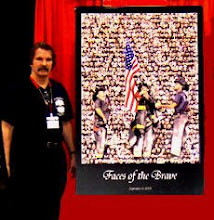Aug. 13, 2005, 1:50AM
RELIVING THE HORROR
Heroes of Sept. 11 finally get a voice
Under a court order, the New York Fire Department releases crews' recollections
By ROBERT LEE HOTZLos Angeles Times
RESOURCES
Audio:•
Emergency services in New York City on Sept. 11, 2001. (Large mp3 files)
Reports:•
Sept. 11 panel final report •
Sept. 11 panel June 17 report (
Acrobat Reader required)•
Report on Iraq from June 2004 hearings (
Acrobat Reader required)•
Transcripts from April 2004 hearings •
August 2001 report to White House on Osama bin LadenOther:•
9/11 commission Web siteNEW YORK - Each of these city firefighters was a prisoner of memory.
The weeping paramedic who feared that his wife was among those still inside the inferno; the deputy commissioner who fixated on falling aircraft parts because he could not bear to watch the falling bodies; the fire chief who could not stop a new recruit from staggering back into the collapsing ruins; the firefighter who hid under the car and buried his face in his helmet when the first tower fell.
In the confessional of a closed administrative hearing, 503 New York firefighters and paramedics tried one by one to make sense of the call they answered to the World Trade Center towers on Sept. 11, 2001. For more than three years, their testimony had been secret.
But under a court order on Friday, the New York City Fire Department unwillingly bared its soul.
The department released a massive archive of radio calls and oral histories compiled by the firefighters who rushed into the chaos of the Twin Towers, where 343 of them ultimately died.
Through 12,000 pages of oral history transcripts and recordings of emergency radio traffic that filled 23 compact discs, a day that became a patriotic talisman of national resolve dissolved back into the irreconcilable fragments of carnage, horror and heroism on a September morning when two hours seemed an eternity.
The New York Court of Appeals ordered the edited material made public in response to a lawsuit by The New York Times. The tapes and transcripts were withheld on the direction of the U.S. Attorney's office, which had been prosecuting Zacarias Moussaoui, said Virginia Lam, spokeswoman for the New York Fire Department. Moussaoui pleaded guilty in April to charges in connection with the 9/11 plot.
The department began collecting oral histories in October 2001, when memories were sharp and recriminations raw.
As the firefighters, paramedics and administrators responded to laconic questions from a panel of three department officials, there appeared to be little effort to conduct a postmortem on operational matters.
Instead, each delivered an intimate, often emotional, account of the day's events, as if the department intended only to give its personnel an opportunity to purge themselves of whatever memories might be haunting them.
Often resorting to the cryptic language of emergency management — in which a "1040" is an airplane hitting a building and an "evulsion" is a slashed scalp — the firefighters unburdened themselves.
It was the office workers leaping from the towers to escape the flames that firefighter Maureen McArdle-Schulman could not block from her mind.
"Somebody yelled something was falling. We didn't know if it was desks coming out. It turned out it was people coming out, and they started coming out one after the other."
Emergency medical technician Mary Merced was transfixed. The images remained vivid. "I see debris drop. And I look, and it was people. I could tell you almost every color clothing all the people that I saw fall had on, how they fell, if they tumbled, if they swan-dived."
Merced gripped the hand of a co-worker to keep him from running into the burning tower. "Everything is in like slow motion, like time stood still." Then the south tower collapsed, the first to fall. "It was like in dark hell, like a nuclear blizzard."
Firefighter James Curran remembered that he made it to the 31st floor of the north tower and forced the door open. "You smelled jet fuel right away, so we shut the door." He retreated to the 30th floor with about 60 other firefighters. There, lighted only by the emergency strobes and flashlights, they huddled to catch their breath.
Trying to evacuate a women with a broken leg, FDNY Lt. Spiro Yioras sought shelter underneath a pedestrian overpass. Even so, he was pummeled by debris. "A couple of things hit me ... bricks or wood. But it hurt. It hurt," he recalled.
"We couldn't see anything. We couldn't breathe. I mean, I thought I was going to buy it. I really thought I was going to die in there."
When fire Chief Mark Steffens pulled his car onto West Street adjacent to the site, the destruction stunned him.
"It was just like nothing I have ever seen in my life. All the apparatus, the fire trucks, everything all blown out. The windows were all blown out, body parts lying on the street, mud, soot, people walking around dazed."
Steffens could not shake the memory of a lone probationary fireman he encountered on the street.
"I saw one proby — he had 'proby' on the helmet — by himself, walking by himself. I tried to get him to come with us. He said: 'No, no, I've got to go back.' We washed his eyes. I gave him something to clean his face. Then he turned and went back into the cloud. I never saw him again."
"Do you recall his name?" a member of the administrative panel asked.
"No, young, young guy. I didn't want him to go back, and he wouldn't listen to me," Steffens said. "He just walked back into that big black cloud."

